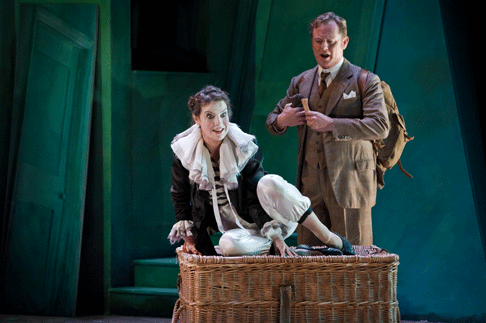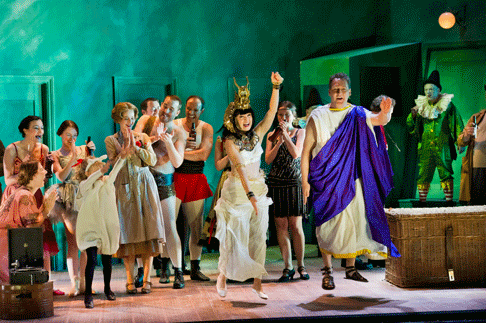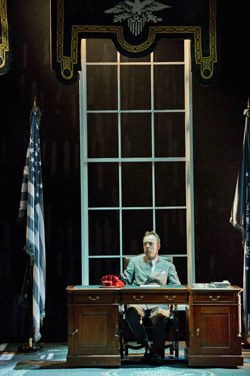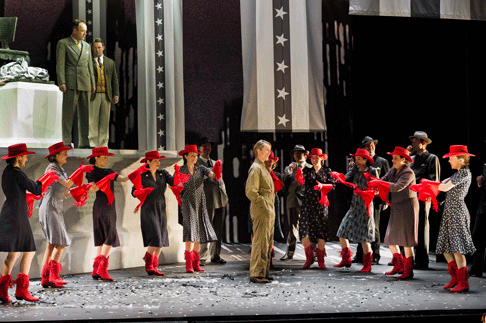The first three operatic
productions, Donizetti’s Maria di Rohan, Handel’s
Saul and Thomas’s Mignon, were all Festival
Productions, an impressive achievement for Greenwood as he hands over the
reigns to incoming director, Stephen Barlow.
Drawn from Goethe’s novel Wilhelm Meisters Lehrjahre, the
libretto of Mignon was rendered by Michel CarrÈ and Jules Barbier into
a comic drama, mingling improbable absurdities with touching tenderness.
Lothario, a wealthy gentleman, has lost his mind after the death of his wife
and the abduction of his daughter, Sperata, whom he desperately seeks.
Kidnapped by the cruel Jarno, the leader of a vagrant band of entertainers, she
now appears as his ‘star turn’, Mignon, a mysterious, androgynous
dancer. Rescued by the altruistic Wilhelm, Mignon falls in love with her
saviour, but he has eyes only for Philine, the dazzling leading lady of a
flamboyant troupe of theatrical players. Inexplicably drawn to Mignon, Lothario
wishes to support her; but she yearns to be with Wilhelm who reluctantly agrees
to let her travel with him, disguised as his male servant. Conflicts increase:
Frederick and Wilhelm fight for Philine’s love, while Mignon’s
jealous hatred of Philine grows. Driven to the edge of madness she agrees to
salvage Philine’s bouquet from a burning theatre, an act of selflessness
which spurs Wilhelm to his second chivalrous rescue mission, and awakens his
ardent passion for Mignon. However, further unfortunate misunderstandings delay
the happy resolution. It is not until Lothario surprisingly declares that the
house where Mignon has been recovering belongs to him that her memory of past
people and places returns; a box of treasures — a child’s doll and
prayer book — sparks the realisation that she is in fact Sperata, his
long lost daughter.
In effect, Mignon presents a sort of sub-Puccinian melodrama: the
shady unemployed theatrical entertainers possess little of the aesthetic
ardency of the Parisian Bohemians; Mignon herself lacks Mimi’s tragic
grandeur. However, the characters are appealing and their dilemmas engaging;
moreover, the tale offered Thomas much potential for both potent expression and
sweet lyricism, and is a work of much musical charm and grace. As Andrew Lamb
notes in his programme essay, Mignon, which marked Thomas’s
return to composition after a spell as an academic, became the composer’s
most successful work, greatly esteemed in its day and performed more than 1500
times from its premiere in 1866 and 1919, after which the forms and idioms it
celebrated fell from fashion.
 Wendy Dawn Thompson as Mignon and Ryan MacPherson as Wilhelm
Wendy Dawn Thompson as Mignon and Ryan MacPherson as Wilhelm
Director Annilese Miskimmon has adopted a suitably light touch, updating the
action to the 1920s, and delighting in the frivolity and sparkle. Her playful
approach is complemented by Nicky Shaw’s economical but visually
appealing sets; director and designer work well together to introduce some neat
dramatic touches. Thus the opening post-theatre party scene sets off with a
swing of energy and jollity, dressing room doors dancing gaily to and fro, as a
flurry of acrobats, ventriloquists, escapologists, magicians and dancers whizz
and whirl across the stage. The limited space is efficiently deployed: at the
end of Act 1, the stage is enveloped in murky smoke to transport us to a dusty,
crowded railway station, an illuminated sign pointing the way to the platforms;
and the burning theatre, engulfed by flames ignited by an increasingly vengeful
and raving Lothario, is effectively realised.
As Wilhelm, American tenor Ryan MacPherson was dramatically credible —
a handsome Hollywood matinee idol – and displayed a truly pleasing voice across
the registers. His fairly light tenor was initially a little grainy when
pushing at the top, but as he relaxed he produced a richer, fuller sound,
particularly in the closing trio.
Despite some adroit gymnastic feats, as she deftly squeezed herself into the
laundry box in which she is imprisoned by the dastardly Jarno, Wendy Dawn
Thompson took a little time to warm up vocally and establish her character.
But, her Act 2 aria ‘Connais-tu le pays’ revealed a glowing, rich
mezzo tone which conveyed Mignon’s innocence and integrity, developing a
deeper psychology as her confusion and suffering are revealed.
Baritone Russell Smythe was a rather jaded Lothario. He had some not
insignificant intonation problems, although these lessened as he settled into
the role; but he did not find a way to effect a transition between
Lothario’s introverted suffering and his aggrieved public outbursts, and
Smythe’s tendency to bellow to convey both anger and despair reduced our
sympathy for the bereaved and lonely man.
 Gillian Keith as Philine and Andrew Mackenzie-Wicks as Laerte
Gillian Keith as Philine and Andrew Mackenzie-Wicks as Laerte
Indian tenor Amar Muchhaka was a likeable Frederick, but the star of the
show was undoubtedly, and fittingly, Gillian Keith as the dazzling diva,
Philine. Keith relished the giddy theatricality of her show-stopping Polonaise
and despatched the coloratura of ‘Je suis Tytania’ with aplomb. Her
dressing-room door appropriately sported a glittering star; and it was no
surprise that her excessive luggage required the heft of several strapping
chaps to hoist it onto the departing train.
Opera enthusiasts can take an infinite number of improbabilities and
coincidences in their stride, but there is an innate problem with
Mignon in that the plot does not successfully combine or integrate the
comic and tragic strands. Occasionally these sat uncomfortably alongside each
other. Thus, the ‘play-within-a-play’ performance of A
Midsummer Night’s Dream — during which the simple-minded
rustics dotingly worship Tytania as she is born aloft upon a crescent moon
— was effectively presented (mechanical malfunction adding a further
piquant touch), but it was then a rather abrupt switch to Mignon’s
increasing distress and despair as she embarked upon a suicide dash into the
flames.
Despite this, and the libretto’s somewhat uneven dispersal of dramatic
events, energetic conducting by Andrew Greenwood drew lively playing from the
Northern Chamber Orchestra and kept the show moving swiftly on to its happy, if
slightly implausible, resolution.
Similar imaginative leaps were demanded of the audience by Olivia
Fuchs’ production of Handel’s Saul the following evening.
In a programme article Fuchs notes that Charles Jennens’ libretto, based
on the first book of Samuel, reflects some of the social and political events
of the day, and that the challenge is to “[find] another context closer
to our own experience that reflects the universal concerns of nationhood, power
and its subsequent abuse”. Fuchs thus updates the biblical action to
post-WW2: Saul is a physically commanding but psychologically insecure US
president and Daniel a dashing young pilot, fresh from heroic exploits which,
judging from the exploding mushroom cloud in the opening visual sequence,
presumably included dropping the nuclear bomb on Hiroshima.
 Jonathan Best as Saul
Jonathan Best as Saul
While, generally, attention to detail is a good thing, it is possible to be
overly specific and precise. Certainly Saul, composed shortly after
the Glorious Revolution, raises questions about leadership, the legitimacy of
rule and dynastic succession, and explores the effects of power upon the
individual and the community. Such abstract concepts translate with relevance
to our own age, but Fuchs’ declaration that Saul “shows us
the way a nation establishes itself as a superpower, how it justifies war as a
means of defence and a way of establishing national identity” seems to be
taking things a bit too far. By pinpointing particular moments in
twentieth-century history with such precision, Fuchs and designer Yannis
Thavoris try to create parallels that are not always credible or sustainable:
the victory chorus which opens Act 1 is now a VJ parade, the subsequent
conflict with the Philistines becomes the Korean war (making nonsense of the
text — who are the ‘Uncircumcised’ in 1950?), and Daniel only
narrowly avoids a ‘Lewinsky moment’ in the Oval Office in Act 2!
Another problem, inherent in the genre, is what to do with the chorus. In
opera seria, the ‘chorus’ was not a separate entity but
simply an ensemble for the soloists, usually performed as a tableau at the
start or end of each act before the sequence of individual da capo
arias; but in his oratorios, Handel uses the chorus as a sort of Greek chorus
which comments on the action as it develops and provides a moral benchmark for
the audience. The difficulty in a dramatic staging of the work is therefore how
to integrate the chorus plausibly in the action. Choreographer Clare Whistler
certainly tried to suggest the chorus’ unity of thought and judgement,
ritualistically assembling the members in sequence, using imitation and
repetition of movement to indicate collective judgements and beliefs. Yet,
there was frequently too much fuss and busyness: umbrellas were certainly
requisite outside the house during an unseasonable wet week, but were they
really essential as a prop for a well-drilled choral routine? The
‘meaning’ of such gestures, like the twisting hand movements that
opened Act 2, was often obscure or plain daft (were the chorus’ lime
green hands supposed to indicate Saul’s envy which the people condemn?).
Moreover, they distracted both the chorus from watching the beat, and the
audience from focusing on what was otherwise some fine ensemble singing.
Jonathan Best was strong in the title role, conveying the paranoia and
jealous anguish of the eponymous ruler with intelligence and conviction. Robert
Murray presented a thoughtful portrait, musically focused and dramatically
engaging; but as Saul’s two daughters, Merab and Michal, Elizabeth
Atherton and Ruby Hughes respectively made less dramatic impact and
Hughes’ projection was rather weak at times. Most impressive of the cast
was Anne Marie Gibbons, a stunning David, who used her burnished lower register
to convey significant emotional depth as the young man experiences fresh hopes,
passions and fears. One wonders, though, despite Gibbons’ beautiful
legato line and sensitive decorative embellishments, whether the role
should not really be taken by a countertenor, as Handel envisaged. In a silent
role, as the Witch of Endor, Andrew Mackenzie-Wicks was dramatically effective
(he was similarly assured in the small role of Laerte in Mignon the
previous evening).
 Jonathan Best as Saul, Robert Murray as Jonathan, Anne Marie Gibbons as David, with the Festival chorus
Jonathan Best as Saul, Robert Murray as Jonathan, Anne Marie Gibbons as David, with the Festival chorus
Conducting the Orchestra of the Sixteen, Harry Christophers established a
lively momentum in Act 1 but, while alert to the musical details, he was not
entirely successful in sustaining dramatic urgency, particularly through the
series of slow arias in Act 3. One innate problem is that the musical
involvement of David actually decreases in inverse proportion to his dramatic
significance and growing power. And, Christophers wasn’t helped by the
frequent hiatuses necessitated by numerous scene changes, including one
(presumably unintentional) long pause between the scenes of the final act,
which destroyed the musical and dramatic impetus.
In addition to the in-house productions and operas presented by visiting
companies, the Festival offers a Literary Series, walks, a vibrant Fringe
scene, and a concert programme, Mainly Music. On Tuesday 18th July the Frith
Piano Quartet were on fine form in a recital of both well-known and unfamiliar
chamber music by Dvoř·k. Taking advantage of the presence of a harmonium
in the Pavilion Arts Centre, they began with the seldom performed Five
Bagatelles, Op.47, Alistair Young’s warm harmonium tones blending
sympathetically with the folk-inspired melodies of the strings, which are
developed in variation form through a range of tempi and moods. Young was
replaced by pianist Benjamin Frith in Dvoř·k’s second Piano Quartet
in E-flat Op.87. The precision of the ensemble, led confidently and with
stylistic panache by Robert Heard, was impressive: the instrumentalists
responded sensitively as individual lines rose and fell within the energetic
textures, Frith’s vigorous piano motifs never over-shadowing the strings.
Louise Williams enjoyed the opportunities afforded by the composer to display
her rich viola tone, while ‘cellist Richard Jenkinson provided strong
rhythmic impetus, his athletic and precise pizzicato particularly
note-worthy.
The 2012 Festival promises more such delights, with a programme scheduled to
include more Handel, Strauss’s Intermezzo and Sibelius’s
The Maiden in the Tower.
Claire Seymour
Cast Lists:
Mignon
Mignon: Wendy Dawn Thompson; Philine: Gillian Keith; Wilhelm: Ryan
MacPherson; Lothario: Russell Smythe; Laerte: Andrew Mackenzie-Wicks; Jerno:
Mark Holland; Frederick: Amar Muchhala. Conductor: Andrew Greenwood. Director:
Annilese Miskimmon. Designer: Nicky Shaw. Lighting: John Bishop. Buxton Opera
Festival 2011, Saturday 16th July 2011.
Saul
Saul: Jonathan Best; Jonathan: Robert Murray; David: Anne Marie Gibbons;
Merab: Elizabeth Atherton; Michal: Ruby Hughes; Witch of Endor: Andrew
Mackenzie-Wicks; Ghost of Samuel: Andrew Slater; High Priest: Andrew
Mackenzie-Wicks; Doeg: Philip Gault. Conductor: Harry Christophers. Director:
Olivia Fuchs. Designer: Yannis Thavoris. Choreographer: Clare Whistler.
Lighting designerJohn Bishop. Buxton Opera Festival 2011, Sunday 17th July
2011.
image=http://www.operatoday.com/mignon_gillian-keith-276.gif
image_description=Gillian Keith as Philine [Photo by Robert Workman courtesy of Buxton Opera Festival]
product=yes
product_title=Ambroise Thomas: Mignon; Georg Frederic Handel: Saul
product_by=See body of review for cast lists.
product_id=Above: Gillian Keith as Philine
All photos by Robert Workman courtesy of Buxton Opera Festival